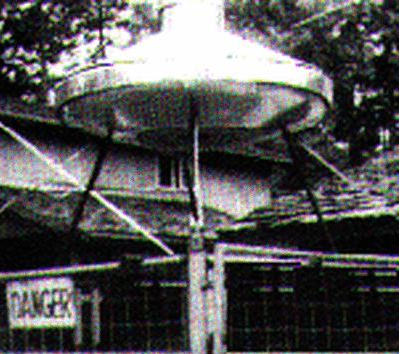The Hamel Device
Explanation of the Hamel Device

As with all the anti-gravity devices the main idea is to create an isolation field around the device to shield from gravity (essentially a magnetic bubble). My understanding is that this can be achieved by creating a magnetic vortex/toroid around the device. The magnetic Toroid should be of sufficient field strength, magnetic particle density and frequency to ensure gravity particles cannot penetrate the shield (toroid boundary). This can be achieved by making sure the toroid is dynamic (spin/vibrate) - to ensure proper/random particle distribution (particles need to form a mesh). Furthermore, the shield can further be enhanced, by creating concentric toroids (spinning in opposite directions) to further increase the magnetic particle density (there should be no gaps in the shield). So, essentially, we’d need a device to generate toroidal magnetic fields - a magnetic toroid generator. The SEG is such a device - I believe Hamel device also produces a toroidal magnetic field that envelops the device.
This is just some thoughts I have about this device:
If we look closely at the Hamel Device we observe 3 magnetic rings - each ring creates a magnetic toroid due to the doughnut shaped magnetic ring. The original design had the magnets facing outwards (horizontal). I believe this to be an error.. magnets should be facing vertical N/S facing top/bottom. Each ring should be of opposite polarity (in attraction). Given this configuration the magnetic field produces the shape of a toroid, where there is a clear inlet and outlet of particles (top/bottom). The dynamic aspect is achieved by the vibration of the magnetic rings, resulting in the magnetic particles (and charged particles) to form a magnetic vortex.
In order to see any affects though, the magnetic fields would need to increase in field strength (magnetic particle density) and relative motion/vibration would also need to increase exponentially as the device operate. So, the question is how do we construct this device to allow for an increase in the magnetic field strength and vibration. Clearly the bottom oscillating plate and the top activation magnet has something to do with ensuring the cones vibrate/move. To increase the magnetic field strength there would also have to be some sort of charge flowing (discharges) to create complimentary magnetic fields.
The only way to ensure we have current discharges is if the device is built as a static electricity generator - where the cones (aluminum) represent capacitors, that builds up charge and discharges when a break-down voltage is achieved. So, the discharge would be from the cones to the outer shell - across the vertical facing cone magnets - this results in a homopolar motor affect being invoked as the charge move from the center/vertex of the cone towards the cone base and across the cone magnets (perpendicular to the magnetic field) and to the outer shell - this applies tangential force on the cones (per homopolar affect), resulting in rotational motion - however, cones do not rotate (due to device configuration), but results in an increase in vibrational energy of the cones. Furthermore, the cone magnetic rings serves as a vibrating magnetic bottles that traps charge and causes charge to swirl around the magnetic ring (imagine these as the rollers of the Searl (SEG) device - where these rollers spin and rotate around the magnetic ring). These swirling charge vortexes results in the amplification of the magnetic fields of the rings - increasing the magnetic particle density of the magnetic toroid.
So, the question is how do we get the cones to charge? Maybe the bottom oscillator serves as a Van De Graaf type electro static generator - where the bottom of the oscillator is electrically connected to the outer metal shell and the balls serve to transfer/pump charge from the bottom plate (of the oscillator) to the top plate (of the oscillator) - or maybe via electrostatic induction? As the oscillator plates move horizontally the balls causes them to move vertically as well. So, if there is a slight charge imbalance between the oscillator plates there could be a pumping action as vibrating plates tries to balance the charge. The cones are in contact with the top plate and each other. And if cones are barely touching (each other) charge can be transferred in this manner as well - like a diode where charge can only flow from the bottom and through the cones and across the cone bases to the shell (completing the circuit).
Also, to get everything started the top activation magnet needs to vibrate at the resonant frequency (could also use a speaker) of the device - once the device is activated (charged) it should hopefully be self-running.
So, when you construct your cones make sure you construct them as capacitors - smooth aluminum surface, the cone base magnetic ring should be isolated from the cone - just a like a plate capacitor use some sort of dielectric material to buffer the cone magnetic ring from the cones. This allows charge to build up to sufficient charge density on the cones and allows the charge jump over to the magnetic ring and subsequently to the outer shell - the greater the discharge the stronger the homopolar affect. You can test this by building the cone as a homopolar motor and applying high voltage (from vertex to base) and see if it moves during discharges - maybe get your first cone done and making it float and applying the high voltage.
Your oscillator may have to be conductive as well to allow for the charge pumping affect - Hamel used granite for his balls - maybe that adds to the charging affect? Wandering quarts crystal balls may generate charge as well - does granite share the same quality?
https://rimstar.org/sdprop/hamlshfs/hamlshfs.htm
https://rimstar.org/sdprop/hamlinvc/hamlinvc.htm
https://www.nighttimepodcast.com/episodes/david-hamel
https://www.htdignam.com/david-hamel.html
https://www.padrak.com/ine/SINCLAIRE1.html
https://www.teslatech.info/ttstore/conftapes/archives/1999jul/600211.htm



